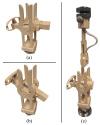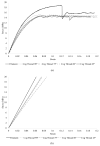Development and Simulation-Based Validation of Biodegradable 3D-Printed Cog Threads for Pelvic Organ Prolapse Repair
- PMID: 40805515
- PMCID: PMC12348529
- DOI: 10.3390/ma18153638
Development and Simulation-Based Validation of Biodegradable 3D-Printed Cog Threads for Pelvic Organ Prolapse Repair
Abstract
Pelvic organ prolapse (POP) is a prevalent condition, affecting women all over the world, and is commonly treated through surgical interventions that present limitations such as recurrence or complications associated with synthetic meshes. In this study, biodegradable poly(ϵ-caprolactone) (PCL) cog threads are proposed as a minimally invasive alternative for vaginal wall reinforcement. A custom cutting tool was developed to fabricate threads with varying barb angles (90°, 75°, 60°, and 45°), which were produced via Melt Electrowriting. Their mechanical behavior was assessed through uniaxial tensile tests and validated using finite element simulations. The results showed that barb orientation had minimal influence on tensile performance. In simulations of anterior vaginal wall deformation under cough pressure, all cog thread configurations significantly reduced displacement in the damaged tissue model, achieving values comparable to or even lower than those of healthy tissue. A ball burst simulation using an anatomically accurate model further demonstrated a 13% increase in reaction force with cog thread reinforcement. Despite fabrication limitations, this study supports the biomechanical potential of 3D-printed PCL cog threads for POP treatment, and lays the groundwork for future in vivo validation.
Keywords: biodegradable cog threads; finite element analysis (FEA); pelvic organ prolapse (POP); vaginal wall reinforcement.
Conflict of interest statement
The authors declare no conflicts of interest.
Figures








Similar articles
-
Biomechanical evaluation of biodegradable PCL cog threads for prolapse rehabilitation.Proc Inst Mech Eng H. 2025 Jul;239(7):687-696. doi: 10.1177/09544119251343371. Epub 2025 Jul 7. Proc Inst Mech Eng H. 2025. PMID: 40624901
-
Prescription of Controlled Substances: Benefits and Risks.2025 Jul 6. In: StatPearls [Internet]. Treasure Island (FL): StatPearls Publishing; 2025 Jan–. 2025 Jul 6. In: StatPearls [Internet]. Treasure Island (FL): StatPearls Publishing; 2025 Jan–. PMID: 30726003 Free Books & Documents.
-
Surgery for women with pelvic organ prolapse with or without stress urinary incontinence.Cochrane Database Syst Rev. 2018 Aug 19;8(8):CD013108. doi: 10.1002/14651858.CD013108. Cochrane Database Syst Rev. 2018. PMID: 30121956 Free PMC article.
-
Surgical management of pelvic organ prolapse in women.Cochrane Database Syst Rev. 2013 Apr 30;(4):CD004014. doi: 10.1002/14651858.CD004014.pub5. Cochrane Database Syst Rev. 2013. Update in: Cochrane Database Syst Rev. 2016 Nov 30;11:CD004014. doi: 10.1002/14651858.CD004014.pub6. PMID: 23633316 Updated.
-
Surgical management of pelvic organ prolapse in women.Cochrane Database Syst Rev. 2010 Apr 14;(4):CD004014. doi: 10.1002/14651858.CD004014.pub4. Cochrane Database Syst Rev. 2010. Update in: Cochrane Database Syst Rev. 2013 Apr 30;(4):CD004014. doi: 10.1002/14651858.CD004014.pub5. PMID: 20393938 Updated.
References
-
- Mudalige T., Pathiraja V., Delanerolle G., Cavalini H., Wu S., Taylor J., Kurmi O., Elliot K., Hinchliff S., Atkinson C., et al. Systematic review and meta-analysis of the pelvic organ prolapse and vaginal prolapse among the global population. BJUI Compass. 2025;6:e464. doi: 10.1002/bco2.464. - DOI - PMC - PubMed
-
- Zumrutbas A.E. Understanding Pelvic Organ Prolapse: A Comprehensive Review of Etiology, Epidemiology, Comorbidities, and Evaluation. SociéTé Int. d’Urologie J. 2025;6:6. doi: 10.3390/siuj6010006. - DOI
Grants and funding
LinkOut - more resources
Full Text Sources

